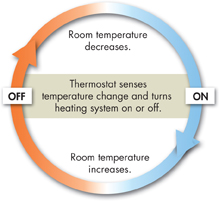Homeostasis
 What is homeostasis?
What is homeostasis?
Some things are easy to observe. When you run or swim or even write the answer to a test question, you can see your body at work. But behind the scenes, your body's systems are working constantly to do something that is difficult to see and that few people appreciate—maintaining a controlled, stable internal environment. This stable environment is called homeostasis, which means “similar standing.”  Homeostasis describes the relatively constant internal physical and chemical conditions that organisms maintain despite changes in internal and external environments. Homeostasis may not be obvious, but for a living organism, it's literally a matter of life or death.
Homeostasis describes the relatively constant internal physical and chemical conditions that organisms maintain despite changes in internal and external environments. Homeostasis may not be obvious, but for a living organism, it's literally a matter of life or death.
Feedback Inhibition If you've ever watched someone driving a car down a relatively straight road, you may have noticed how the person constantly moves the wheel left or right, adjusting direction to keep the vehicle in the middle of the lane. In a certain sense, that's how the systems of the body work, too, keeping internal conditions within a certain range, and never allowing them to go too far to one side or the other.

FIGURE 30–3 Feedback Inhibition A home heating system uses a feedback loop to maintain a stable, comfortable environment within a house. Interpret Diagrams What is the stimulus in this feedback loop?
d▸ A Nonliving Example One way to understand homeostasis is to look at a nonliving system that automatically keeps conditions within a certain range like a home heating system. In most homes, heat is supplied by a furnace that burns oil or natural gas. When the temperature within the house drops below a set point, a thermostat sensor switches the furnace on. Heat produced by the furnace warms the house. When the temperature rises above the set point, the thermostat switches the furnace off, keeping the temperature within a narrow range.
A system like this is said to be controlled by feedback inhibition. Feedback inhibition, or negative feedback, is the process in which a stimulus produces a response that opposes the original stimulus. Figure 30–3 summarizes the feedback inhibition process in a home heating system. When the furnace is switched on, it produces a product (heat) that changes the environment of the house (by raising the air temperature). This environmental change then “feeds back” to “inhibit” the operation of the furnace. In other words, heat from the furnace eventually raises the temperature high enough to trigger a feedback signal that switches the furnace off. Systems controlled by feedback inhibition are generally very stable.
BUILD Vocabulary
ACADEMIC WORDS The noun inhibition means “the act of blocking the action of.” Therefore, feedback inhibition refers to a response that blocks further actions of a stimulus.
 In Your Notebook Describe another example of a nonliving system that requires constant adjustment.
In Your Notebook Describe another example of a nonliving system that requires constant adjustment.

Table of Contents
- Formulas and Equations
- Applying Formulas and Equations
- Mean, Median, and Mode
- Estimation
- Using Measurements in Calculations
- Effects of Measurement Errors
- Accuracy
- Precision
- Comparing Accuracy and Precision
- Significant Figures
- Calculating With Significant Figures
- Scientific Notation
- Calculating With Scientific Notation
- Dimensional Analysis
- Applying Dimensional Analysis




